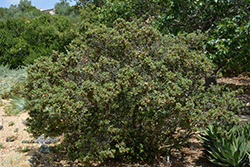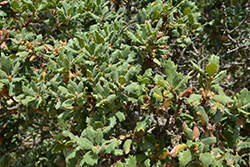It's all about ...
plants

Height: 8 feet
Spread: 8 feet
Sunlight:
![]()
Hardiness Zone: 8b
Description:
A small, slow growing and long lived evergreen shrub that eventually forms a dense mounded habit featuring leathery, convex oval leaves with sharply pointed tips; small oval to cylindrical acorns; provide occasional summer water until established
Ornamental Features
Leather Oak has dark green foliage with grayish green undersides on a plant with a mounded habit of growth. The spiny oval leaves remain dark green throughout the winter. It produces olive green acorns with chartreuse blush from mid summer to mid fall, which fade to tan over time. The fruit can be messy if allowed to drop on the lawn or walkways, and may require occasional clean-up.
Landscape Attributes
Leather Oak is a dense multi-stemmed evergreen shrub with a mounded form. Its average texture blends into the landscape, but can be balanced by one or two finer or coarser trees or shrubs for an effective composition.
This shrub will require occasional maintenance and upkeep, and is best pruned in late winter once the threat of extreme cold has passed. It is a good choice for attracting birds and squirrels to your yard, but is not particularly attractive to deer who tend to leave it alone in favor of tastier treats. Gardeners should be aware of the following characteristic(s) that may warrant special consideration;
- Messy
- Spiny
Leather Oak is recommended for the following landscape applications;
- Mass Planting
- Hedges/Screening
- General Garden Use
- Naturalizing And Woodland Gardens
Planting & Growing
Leather Oak will grow to be about 8 feet tall at maturity, with a spread of 8 feet. It has a low canopy with a typical clearance of 1 foot from the ground, and is suitable for planting under power lines. It grows at a slow rate, and under ideal conditions can be expected to live to a ripe old age of 150 years or more; think of this as a heritage shrub for future generations!
This shrub should only be grown in full sunlight. It prefers dry to average moisture levels with very well-drained soil, and will often die in standing water. It is considered to be drought-tolerant, and thus makes an ideal choice for xeriscaping or the moisture-conserving landscape. This plant does not require much in the way of fertilizing once established. It is not particular as to soil pH, but grows best in sandy soils, and is able to handle environmental salt. It is highly tolerant of urban pollution and will even thrive in inner city environments. This species is native to parts of North America.
This plant is not reliably hardy in our region, and certain restrictions may apply; contact the store for more information.

